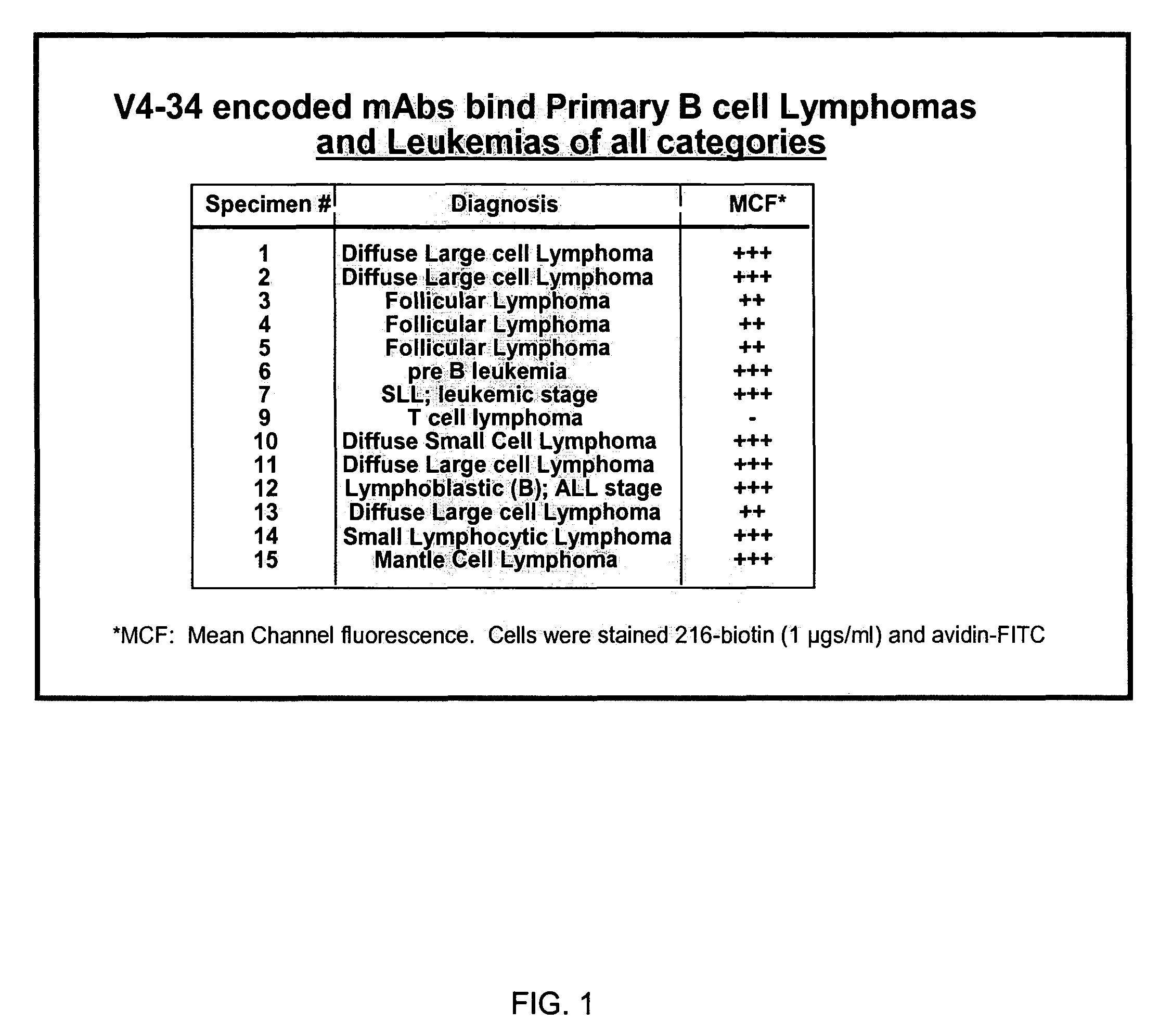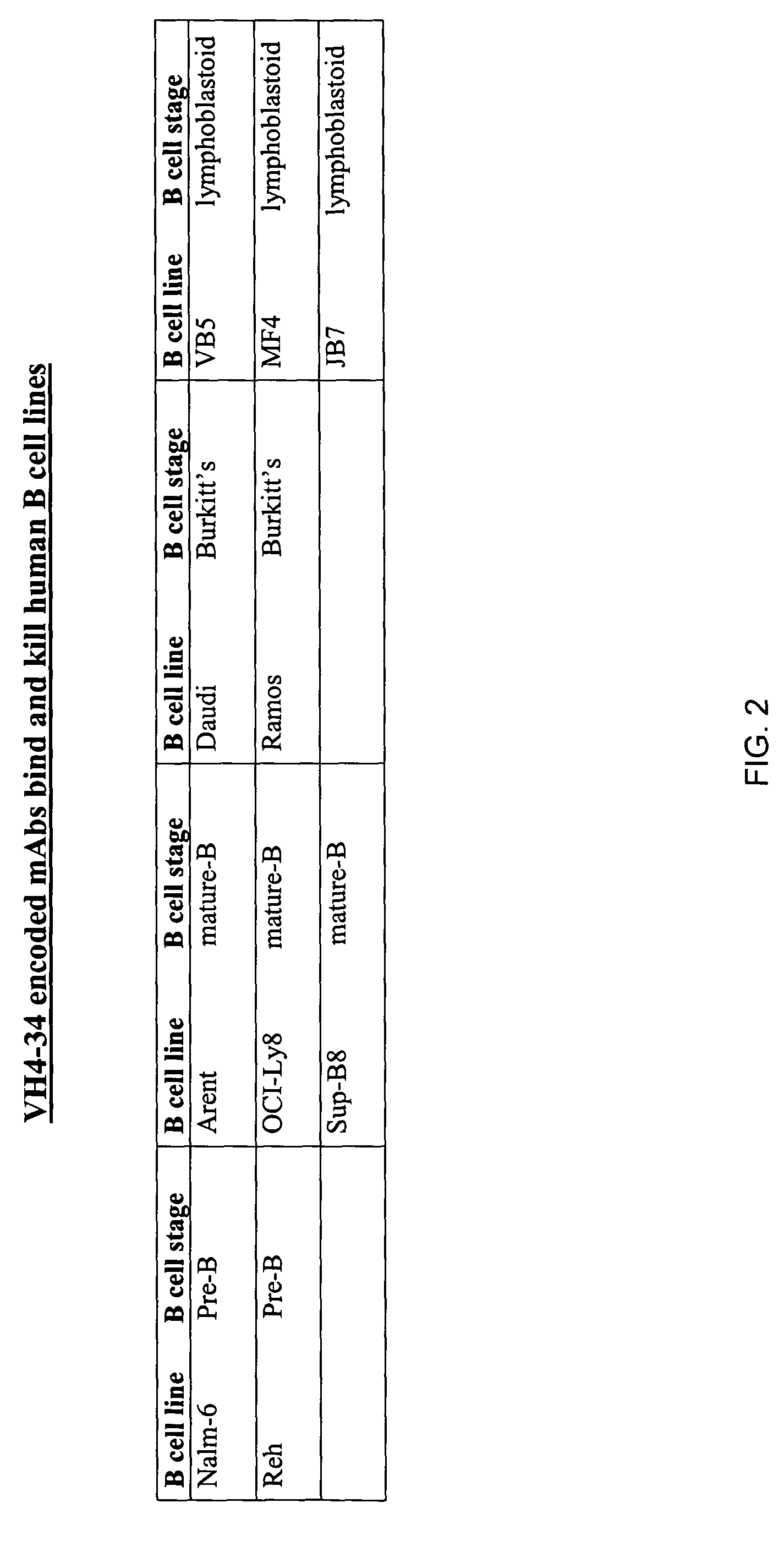Antibody induced cell membrane wounding
a cell membrane and antibody technology, applied in antibody medical ingredients, immunological disorders, metabolism disorders, etc., can solve the problems of not being taught or suggested to induce cell membrane wounding as a research tool or a therapeutic approach, and the agent that binds to a cell surface antigen to induce cell membrane wounding has not been suggested. , to achieve the effect of enhancing cytotoxicity and enhancing the killing of hyperproliferating cells
- Summary
- Abstract
- Description
- Claims
- Application Information
AI Technical Summary
Benefits of technology
Problems solved by technology
Method used
Image
Examples
example 1
mAb 216 Wounds B Cell Membranes and Invokes a Resealing Response by Lysosomes
[0190]The natural response to membrane damage is rapid resealing by addition of internal lysosomal membrane at the wound site. Lamp-1 is an abundant lysosomal membrane glycoprotein normally not present on the plasma membrane (Granger, B. L., et al. (1990) J. Biol. Chem. 265, 12036; McNeil, P. L. (2002) J. Cell Sci. 115, 873). When lysosomes are induced to fuse with plasma membrane, the intra-lysosomal NH2-terminal domain of Lamp-1 becomes exposed on the cell surface. This fusion event can be monitored by surface staining of live cells with mAbs directed to the lumenal epitope of Lamp-1 (Reddy, A., et al. (2001) Cell 106, 157; Rodriguez, A., et al. (1997) J. Cell. Biol. 137, 93; Martinez, I., et al. (2000) J. Cell. Biol. 148, 1141). Thus, the presence of Lamp-1 on the cell surface is an indication of membrane resealing following membrane disruption (McNeil, P. L., and R. A. Steinhardt (2003) Ann. Rev. Cell D...
example 2
Repair of mAb 216 Induced Membrane Damage is Dependent on Functional Actin
[0203]As discussed by McNeil, P. ((2002) J. Cell Sci. 115, 873) and others, membrane wound repair involves actin dependent processes. To test whether repair of membrane wounding induced by mAb 216 utilizes actin dependent repair mechanisms, cells were treated with agents that affect actin polymerization, and the effect on the repair of the membrane wound induced by mAb 216 was assessed. Cells were treated with cytochalasin or jasplakinolide, two agents that have opposite effects on actin polymerization. Cytochalasin depolymerizes actin into monomers, whereas jasplakinolide, a cyclic peptide obtained from a marine sponge, immobilizes actin in its filamentous form. Both treatments hinder actin-based cytoskeletal activities.
Methods:
[0204]Cytochalasin was obtained from Sigma and jasplakinolide was obtained from Molecular Probes (Eugene, Oreg.). Caspase inhibitors, Ac-IETD-CHO and Ac-DEVD-CHO were obtained from Pha...
example 3
Repair of mAb 216 Induced Membrane Damage is Dependent on Calcium
[0208]Since exocytosis of lysosomes is known to be a calcium dependent phenomenon (Miyake, K., and P. L. McNeil (1995) J. Cell Biol. 131, 1737; Bi, G. Q., et al. (1995) J. Cell Biol. 131, 1747), membrane wounding by mAb 216 and repair of the wound was tested in calcium free and normal calcium conditions. The cell viability of Nalm-6 cells when treated with two VH4-34 encoded mAbs, mAb 216 at 50, 25 and 12.5 ng / ml concentrations, and Y2K at 50 ng / ml, was tested in the presence of media with and without calcium. As shown in FIG. 6A, cell viability decreased significantly in the absence of calcium, indicating that calcium was necessary for the wound repair. Cells treated with control antibodies or no antibody did not show any change in cell viability in the presence or absence of calcium. Other B cell lines, OCI-Ly8 and Reh also showed a similar increase in cytotoxicity in calcium-free conditions (data not shown).
PUM
| Property | Measurement | Unit |
|---|---|---|
| molecular weight | aaaaa | aaaaa |
| temperature | aaaaa | aaaaa |
| concentration | aaaaa | aaaaa |
Abstract
Description
Claims
Application Information
 Login to View More
Login to View More - R&D
- Intellectual Property
- Life Sciences
- Materials
- Tech Scout
- Unparalleled Data Quality
- Higher Quality Content
- 60% Fewer Hallucinations
Browse by: Latest US Patents, China's latest patents, Technical Efficacy Thesaurus, Application Domain, Technology Topic, Popular Technical Reports.
© 2025 PatSnap. All rights reserved.Legal|Privacy policy|Modern Slavery Act Transparency Statement|Sitemap|About US| Contact US: help@patsnap.com



